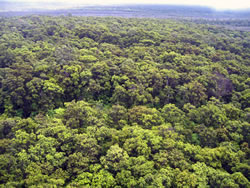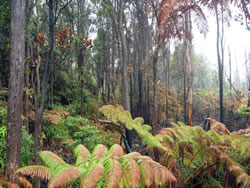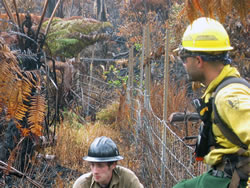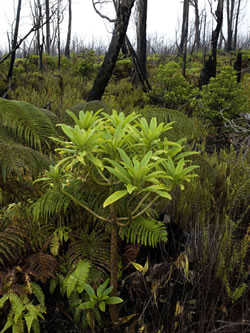National Cohesive Wildland Fire Management Strategy Success Story
Napau Fire Burned Area Rehabilitation
Hawai'i Volcanoes National Park, Hawai'i
Cohesive Strategy - Maintain and Restore Landscapes
2011

Ōhi'a rainforest inside the protected 2,750 acre fence unit.

Fire-damaged 'ōhi'a rainforest.

Feral pig barrier fence damaged by the wildfire.

Haha (Clermontia hawaiiensis) is among the rare lobeliads found in rainforest in Napau. Individuals are particularly vulnerable to damage by pigs that root under plants. This plant re-sprouted following a 2002 wildfire.
In spring 2011, the lava-ignited Napau Fire burned 2,076 acres in Hawaii Volcanoes National Park. Besides burnt vegetation, extensive damage occurred to a one mile section of galvanized steel hogwire fence that protected 2,750 acres of lush ‘ōhi‘a rainforest from the harmful effects of introduced feral pigs.
Non-native feral pigs and invasive plants are the primary threats to Hawaiian rainforest. The islands’ flora evolved in the absence of ungulates (hooved animals) and lack defenses against these animals. Introduced pigs damage native vegetation and cause soil erosion by uprooting and trampling plants, devouring palatable species, and encouraging the spread of invasive non-native weeds. The 3.8 mile long fence protects habitat for the endangered ‘Io or Hawaiian hawk (Buteo solitarius), Kihi fern (Adenophorus periens), a candidate endangered species of mint (Pyllostegia floribunda), five species of concernand additional rare plant species.
A Burned Area Emergency Response (BAER) team, composed of park resource specialists with goals of fire ecology and restoration, was assigned to the incident to assess damage to biological resources, evaluate the potential for natural recovery and recommend actions to assist recovery of the area. They determined that removal of snags along the fence line and replacement of the damaged fence were key actions needed to protect the vegetation recovery in the burn and prevent degradation of unburned areas. Numerous snags weakened by the wildfire had fallen across the fence and caused breaches for pigs to enter the unit. The remaining snags would continue to pose a threat for years to come. Also, the galvanized coating that protected the steel wire from corrosion was damaged by the fire and rapid deterioration of the fence would occur due to the combination of corrosive volcanic fumes being emitted from upwind and the wet climate of the area.
The new fence will replace portions of fence damaged by the wildfire and be re-aligned to reduce the likelihood of damage from future wildfires. Park staff will monitor and remove any animals that enter during the interim while the new fence is constructed and follow-up with routine inspection and maintenance of the fence after construction. Construction began in late summer 2011 and will be completed in fall 2012.
Contact
Rhonda Loh, Chief of Natural Resources
Email: Rhonda_Loh@nps.gov
Phone: (808) 985-6098
Keywords: Fire Ecology and Restoration